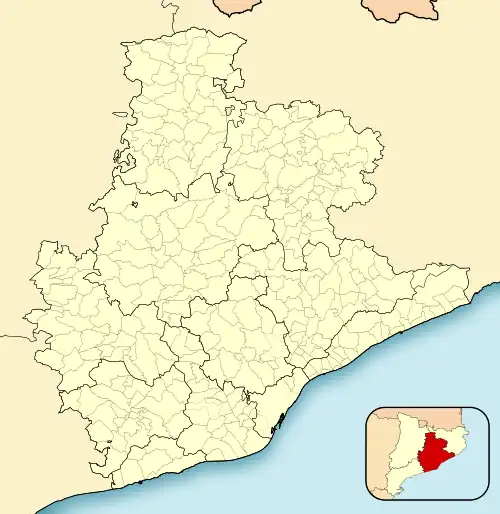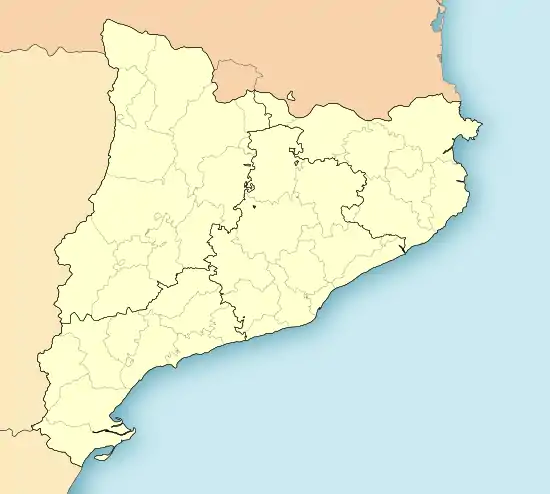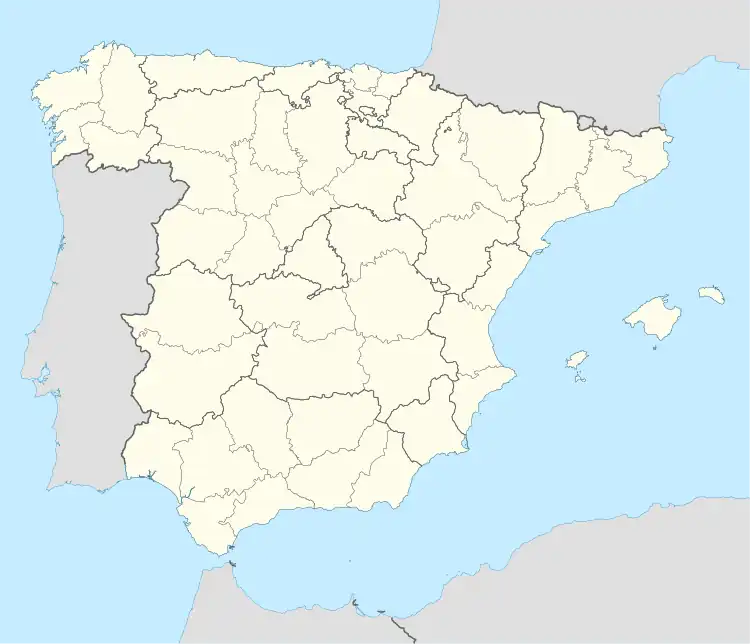Sant Esteve Sesrovires
Sant Esteve Sesrovires (pronounced [ˈsant əsˈteβə səzruˈβiɾəs]; Spanish: San Esteban Sasroviras, lit. 'St. Stephen [of] the Oaks') is a municipality in the northern part of the comarca of Baix Llobregat in Catalonia, Spain. It is situated on the left bank of the Anoia river, close to the A-2 highway, and is served by the FGC railway line R6 from Barcelona and Martorell to Igualada.
Sant Esteve Sesrovires | |
|---|---|
 Barcelona Golf Club, with Sant Esteve Sesrovires behind | |
 Sant Esteve Sesrovires Location in the Province of Barcelona  Sant Esteve Sesrovires Location in Catalonia  Sant Esteve Sesrovires Location in Spain | |
| Coordinates: 41°29′42″N 1°52′28″E | |
| Country | |
| Community | |
| Province | Barcelona |
| Comarca | Baix Llobregat |
| Government | |
| • Mayor | Enric Carbonell[1] |
| Area | |
| • Total | 18.6 km2 (7.2 sq mi) |
| Elevation | 183 m (600 ft) |
| Population (2018)[3] | |
| • Total | 7,800 |
| • Density | 420/km2 (1,100/sq mi) |
| Demonym | Sesrovirenc/-a |
| Website | sesrovires |
Demography
Sant Esteve Sesrovires had a population of 7,771 in 2021, of which 3,910 were men and 3,861 women, according to data from the Statistical Institute of Catalonia (IDESCAT).[4]
- Population of Sant Esteve Sesrovires between 1717 and 2021

Economy
The economy of Sant Esteve Sesrovires has historically benefited from its location close to the city of Barcelona. Manufacturing experienced a period of high growth in the town during the 20th century, going from a factory of wool scarves at the beginning of the century to more than 150 industries today, spread over various industrial estates. Among the companies present in Sant Esteve Sesrovires are the multinational confectionery maker Chupa Chups and the car manufacturer SEAT. The contribution of industry to the Gross Value Added produced in the municipality is therefore significant relative to the wider economy of both Catalonia and the rest of Spain. As a result, the proportion of workers employed in the industrial sector (c. 40%) is double the average in the comarca.[5]
| Sector | EUR, millions | % |
| Agriculture | 0.3 | 0.1% |
| Industry | 203.2 | 36.5% |
| Construction | 13.9 | 2.5% |
| Services | 338.6 | 60.9% |
| Total | 556 |
The GDP per capita in 2019 was approximately €79,800, which was 144.9% higher than that of Catalonia, and 202% higher than that of Spain as a whole.[6][7]
Notable people
- Rosalía Vila, singer
- Enric Bernat, businessman and founder of Chupa Chups
- Pere Tarrés i Claret, medical doctor and Catholic priest
References
- "Ajuntament de Sant Esteve Sesrovires". Generalitat of Catalonia. Retrieved 2015-11-13.
- "El municipi en xifres: Sant Esteve Sesrovires". Statistical Institute of Catalonia. Retrieved 2015-11-23.
- Municipal Register of Spain 2018. National Statistics Institute.
- "Idescat. The municipality in figures". www.idescat.cat. Retrieved 2022-09-09.
- Llobregat, El. "Sant Esteve Sesrovires es el municipio de la comarca con más personas ocupadas en la industria". El Llobregat (in Spanish). Retrieved 2022-10-03.
- "Idescat. El municipi en xifres". www.idescat.cat. Retrieved 2022-10-03.
- "INEbase / Economía /Cuentas económicas /Contabilidad nacional anual de España: principales agregados / Resultados". INE (in Spanish). Retrieved 2022-10-03.
External links
- Government data pages (in Catalan)
| Autoritat del Transport Metropolità Ferrocarrils de la Generalitat de Catalunya | ||||
|---|---|---|---|---|
| Line R6 | ||||
| Barcelona (Plaça d'Espanya) |
↔ | Sant Esteve Sesrovires | ↔ | Igualada |
.svg.png.webp)